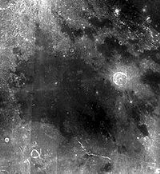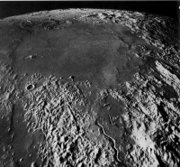
Mare Vaporum
Encyclopedia

Lunar mare
The lunar maria are large, dark, basaltic plains on Earth's Moon, formed by ancient volcanic eruptions. They were dubbed maria, Latin for "seas", by early astronomers who mistook them for actual seas. They are less reflective than the "highlands" as a result of their iron-rich compositions, and...
located between the southwest rim of Mare Serenitatis
Mare Serenitatis
Mare Serenitatis is a lunar mare that sits just to the east of Mare Imbrium on the Moon.It is located within the Serenitatis basin, which is of the Nectarian epoch. The material surrounding the mare is of the Lower Imbrian epoch, while the mare material is of the Upper Imbrian epoch...
and the southeast rim of Mare Imbrium
Mare Imbrium
Mare Imbrium, Latin for "Sea of Showers" or "Sea of Rains", is a vast lunar mare filling a basin on Earth's Moon and one of the larger craters in the Solar System. Mare Imbrium was created when lava flooded the giant crater formed when a very large object hit the Moon long ago...
. The lunar material surrounding the mare is from the Lower Imbrian
Lower Imbrian
In the lunar geologic timescale, the Early Imbrian epoch occurred between 3850 million years ago to about 3800 million years ago. It overlaps the end of the Late Heavy Bombardment of the inner solar system. The impact which created the huge Mare Imbrium basin occurred at the start of the epoch...
epoch
Epoch (geology)
An epoch is a subdivision of the geologic timescale based on rock layering. In order, the higher subdivisions are periods, eras and eons. We are currently living in the Holocene epoch...
, and the mare material is from the Eratosthenian
Eratosthenian
The Eratosthenian period in the lunar geologic timescale runs from 3,200 million years ago to 1,100 million years ago. It is named after the crater Eratosthenes, whose formation marks the beginning of this period. The formation of the crater Copernicus marks its end, and the beginning of the...
epoch. The mare lies in an old basin or crater that is within the Procellarum basin. The mare is 245 kilometres (152.2 mi) in diameter and 55000 km² (21,235.6 sq mi) in area. It may be from the Pre-Imbrian
Lunar geologic timescale
The lunar geological timescale divides the history of Earth's Moon into five generally recognized periods: the Copernican, Eratosthenian, Imbrian , Nectarian, and Pre-Nectarian...
period, which lasted from 4.55 to 3.85 billion years ago. To the south of the mare is a light colored thin line. This feature is Rima Hyginus
Hyginus (crater)
Hyginus is a small lunar caldera located at the east end of the Sinus Medii. Its rim is split by a long, linear rille Rima Hyginus that branches to the northwest and to the east-southeast for a total length of 220 kilometers. The crater is deeper than the rille, and lies at the bend where they...
. The mare is bordered by the mountain range Montes Apenninus
Montes Apenninus
Montes Apenninus are a rugged mountain range on the northern part of the Moon's near side. They are named after the Apennine Mountains in Italy....
. The mare was named by Giovanni Battista Riccioli
Giovanni Battista Riccioli
Giovanni Battista Riccioli was an Italian astronomer and a Catholic priest in the Jesuit order...
in 1651.

